The Mexico City Chronicles: Part II- So Many Museums
- michaellatour
- Sep 29
- 5 min read
The number of museums in this city is too long to try to put in one list, much less fit into one visit- even if that visit is a month long.
In our first post about Mexico City, I highlighted my favorite museum here, The Museo Nacional de Antropología, along with its ‘sequel’, The Museo at Chapultepec Castle, and the archaeological Pyramid site of Teotihuacan. Below is an overview of some of our other favorite museums that we’ve been able to explore.
Templo Mayor
Modern-day Mexico City is built on the ruins of Tenochtitlan, The Capital of the Mexica people prior to the Spanish invasion of 1521. Not many modern cities can boast an active archeological site in the middle of a teeming metropolis, but that’s exactly what is happening here.
The Templo Mayor (or, Major Temple) was the central building of Tenochtitlan and was expanded seven times between 1325 and 1519. This sacred complex, dedicated to the war god Huitzilopochtli and the rain god Tlaloc, served as the center of Mexica religious, political, and cultural life. After the Spanish conquest in 1521, the temple was destroyed, and its ruins were buried under the colonial city.
The discovery of the Coyolxauhqui monolith in 1978 revealed the precise location of the temple, prompting large-scale excavations and the construction of the nearby museum to preserve and display the artifacts. Active archeological work continues to this day, with scientists and excavators working around the tourists, snapping photos.
MUNAL: National Museum of Art
Like many museums in Mexico City, this museum is equally interesting based on the architecture, as well as the art. Mexico City went through a very strong period of classical revival architecture in the late 1800s and early 1900s, and it shows in its public buildings- many of which, like this former Palace of Communications and Public Works, have been converted into museums.
The exhibits here were eclectic. My favorite was an installation that curated different works form different genres, all with the red thread of the Spiritualism movement of the first third of the Twentieth Century. I had been aware of Spiritualism’s impact on The U.S. and Great Britain, but it was fascinating to see how significant it was in Mexico, as well. Another favorite part for both of us was how the architecture of the building became a part of the art on display. The almost gothic frescos, gilding, and dramatic details were as fascinating as the art.
Department of Education
Originally built in 1594 as a convent, The Department of Education Building is an unlikely ‘Museum’ on this list. In the 1850s Mexico enacted Reform Laws that allowed the state to start seizing church assets. By 1867, the nuns were well and gone, and the building began it’s life as a series of government functions (including, for a time, being the home to the National Guard), before becoming the permanent home to the Department of Education in 1921.
Enter Diego Rivera.
Although his prolific sexism is… ahem…. troublesome by today’s standards, there is no denying his importance in both the modern art movement of Mexico (and the world) and in shining a light on workers’ rights and social inequities. Therefore, it was rather forward thinking for then-Education Secretary Jose Vasconcelos to enlist Rivera to bring his Fresco talents to the building.
The courtyard-facing walls on all three floors of the original structure are covered in Rivera’s work. Completed between 1923 (ground floor) and 1928 (third floor), these works not only capture the breadth of his talent, but also act as a time capsule for his career… you can see that he gets progressively more brazen in his political statements as time passes and his social status rises.
Bellas Artes
Another Beautiful Building. The Palacio de Bellas Artes houses both a museum and a theatre (more on the theatre in a future post). Construction began in 1904 under President Porfirio Díaz but was halted for decades by soft soil (an ongoing issue in Mexico City) and the Mexican Revolution. Italian architect Adamo Boari started the project, but Federico Mariscal completed it in 1934, resulting in a building with an Art Nouveau exterior and an Art Deco interior.
During our visits, there were several salas (galleries) closed to the public; thus, we only got to experience two collections. Erik fell in love with Mexican artist Lilia Carillo, who was the subject of an extensive temporary exhibition. My primary focus was on a Diego Rivera Mural in the permanent collection. “Man, Controller of the Universe”, is an expansive piece that Rivera’ painted here after its precursor, “Man at the Crossroads” was painted over in Rockefeller Center. Rivera had been contracted to paint the mural in New York, but John D. Rockefeller objected to the inclusion of Josef Stalin in the image. Rather than compromise his artistic vision, Rivera abandoned the project and returned to Mexico City, where the updated version (which includes both Stalin AND Rockefeller) was created.
The Postal Museum
This strange little museum is actually downtown Mexico City’s functioning Post Office. When you go through one door, you encounter scores of people waiting to do their postal business in this grand setting; when you go through another door, you can buy tickets to venture through the building and explore it’s architecture. It also houses a small museum highlighting the history of the postal service both in Mexico and around the world.
The building took 5 years to build, starting in 1902. It’s known for its strange blend of European classical revival architecture, mixed with Mexican architectural trends at the time. It was heavily damaged in the 1985 earthquake, but extensive repairs in the 1990s restored it to its former glory.
Soumaya Museum
In theory, I love the Soumaya Museum. Founded by Mexican billionaire Carlos Slim Helú in 1994 as a love letter to his late wife Soumaya Domit- a lifelong art lover. In 2011, it moved the bulk of its collection to a breathtaking new building, designed by architect Fernando Romero (which, frankly, surprised me… I totally would have guessed it was Frank Gehry). In a commitment to accessibility of the arts, the Soumaya always has been, and continues to be, free for the public.
For me (well, for us), the challenge is with the curation of the collection. The top floor presents a clear narrative of sculpture and bronze, with a focus on Rodin. But beyond that, the presentation of the collection is… challenging. There are some amazing pieces, but it was often challenging to find them. Despite this challenge, it was a delightful afternoon.
Tamayo Museum
Rufino Tamayo (1899–1991) was a pivotal Mexican artist known for his unique style that blended European modernism with Mexican folk art. A younger contemporary of Diego Rivera, Tamayo was sometimes viewed as the anti-Rivera. His works were broader, more universal, and rejected the political and revolutionary messaging that many of his contemporaries felt were an essential part of early 20th century Mexican art.
The museum named in his honor was designed to provide ample styles of galleries, allowing for a wide array of art installations. With works both two and three dimensional, it is easy to wander through and experience both the works and the space… getting llost along the way.
Museo de Arte Moderno
The Modern Art Museum sits in the Chapultepec forest, where it’s 1960s façade provides a sharp contrast to the bucolic forest setting. The circular building, with large domes incorporated, is surrounded by an amazing sculpture park.
In addition to housing works by global artists like Frida Kahlo, one of the things we loved most about this museum was how it introduced us to artists we’d never heard of. Its focus on Mexican artists provided a great opportunity for us to not only learn about these artists, but also to truly appreciate their works, as many, MANY of the pieces were very much our aesthetic.
.png)































































































































Thank you both for this curated art tour!